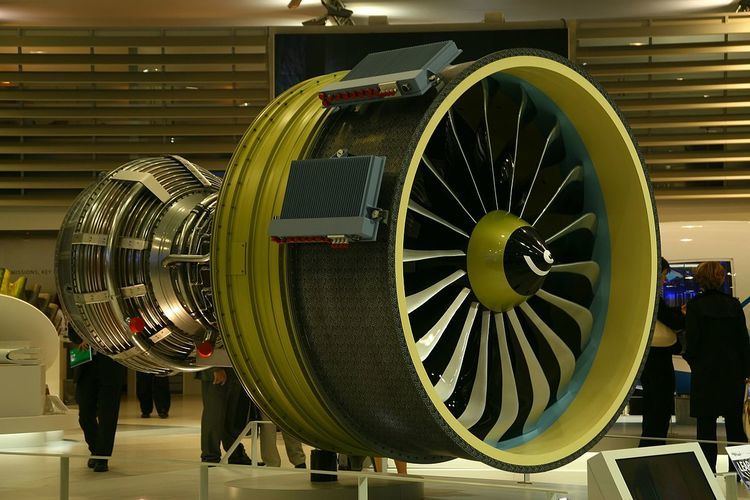 | ||
The CFM International LEAP is a high-bypass turbofan engine. It is produced by CFM International, a 50-50 joint venture company between GE Aviation of the United States and Safran Aircraft Engines (formerly known as Snecma) of France. It is a modernized replacement for the successful CFM International CFM56, intended to compete with the Pratt & Whitney PW1000G in the single-aisle jetliner market.
Contents
Design
The LEAP's basic architecture includes a scaled-up version of Safran's low pressure turbine used on the GEnX engine. The fan has flexible blades manufactured by a resin transfer molding process, which are designed to untwist as the fan's rotational speed increases. While the LEAP is designed to operate at a higher pressure than the CFM56 (which is partly why it is more efficient), GE plans to set the operating pressure lower than the maximum in order to maximize the engine's service life and reliability. Currently proposed for the LEAP is a greater use of composite materials, a blisk fan in the compressor, a second-generation Twin Annular Pre Swirl (TAPS II) combustor, and a bypass ratio around 10-11:1. GE is using ceramic matrix composites (CMC) to build the turbine shrouds.
These technological advances are projected to produce 16% lower fuel consumption. Reliability is also supported by use of an eductor-based oil cooling system similar to that of the GenX, featuring coolers mounted on the inner lining of the fan duct. According to Aviation Week's article, "The eductor device produces a venturi effect, which ensures a positive pressure to keep oil in the lower internal sump." The engine has some of the first FAA-approved 3D-printed components.
Development
The LEAP ("Leading Edge Aviation Propulsion") incorporates technologies that CFM developed as part of the LEAP56 technology acquisition program, which CFM launched in 2005. The engine was officially launched as LEAP-X on 13 July 2008. It is intended to be a successor to the CFM56-5B and CFM56-7B.
In total, 28 test engines will be used by CFM to achieve engine certification, and 32 others will be used by Airbus, Boeing and COMAC for aircraft certification and test programs. The first engine entering the test program successfully reached and sustained 33,000 lbf (150 kN) of thrust, required to satisfy the highest rating for the Airbus A321neo. The same engine ultimately reached 35,000 lbf (160 kN) of thrust in test runs.
General Electric carried out the first test flight, of a LEAP-1C, in Victorville, California, with the engine mounted on the company's Boeing 747 flying testbed, on October 6, 2014, the -1C version features a thrust reverser equipped with a one piece O-ring replacing a 2 piece door. The thrust reverser is deployed by the O-ring sliding aft, reducing the drag that was induced by the older design and improving efficiency. In April 2015, it was reported that the LEAP-1B was suffering up to a 5% shortfall on its promised reduction in fuel consumption.
Orders
The Commercial Aircraft Corporation of China (COMAC) has chosen the LEAP engine for its new COMAC C919 aircraft. The aircraft was due to begin testing in 2016.
On July 20, 2011, American Airlines announced that it planned to purchase 100 Boeing 737 aircraft featuring the LEAP-1B engine. The project was approved by Boeing on August 30, 2011 as the Boeing 737 MAX. Southwest Airlines is the launch customer of the 737 MAX with a firm order of 150 aircraft.
CFM International offers its support for the engine, and signed a 15-year Rate per Flight Hour agreement with Loong Air for 20 LEAP-1A at U.S $333 million, or $3039 per engine per day, in contrast with U.S. $138 million for 17 CFM International CFM56 over 12 years or $1852 per engine per day. As a number of A320neo engine for ANA group of Japan was also ordered in 2014, there is a possibility to select the LEAP engine.
In 2016 CFM booked 1,801 orders, LEAP backlog is at more than 12,200 for more than $170 billion U.S. at list price.
Production
In 2016, the engine was introduced in August on the Airbus A320neo with Pegasus Airlines and CFM delivered 77 LEAP. CFM should produce 500 engines in 2017 with the 737 MAX introduction and 1,100 in 2018. It should reach 2,000 by 2020, to be compared to the 1,700 CFM56 produced in 2016.
To cope with the demand, CFM is duplicating supply sources on 80% of parts and even subdivide assembly sites, already shared between GE and Safran: GE assembles its production in Lafayette, Indiana in addition to its previous Durham, North Carolina facility. As more than 75% of the engine comes from suppliers, critical parts suppliers pass “run-rate stress tests” lasting two to 12 weeks. Pratt & Whitney acknowledges a production ramp-up bottleneck on its rival PW1100G geared turbofan including a critical shortage of the unique aluminium-titanium fan blade, hitting the Airbus A320neo and the Bombardier CSeries deliveries.
